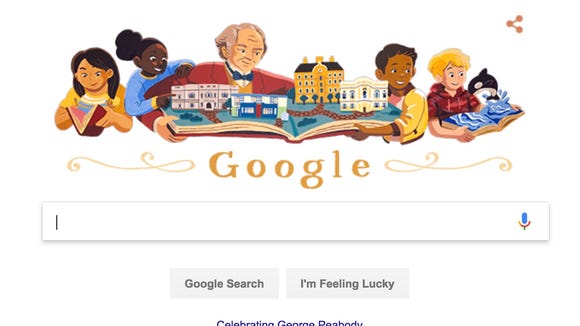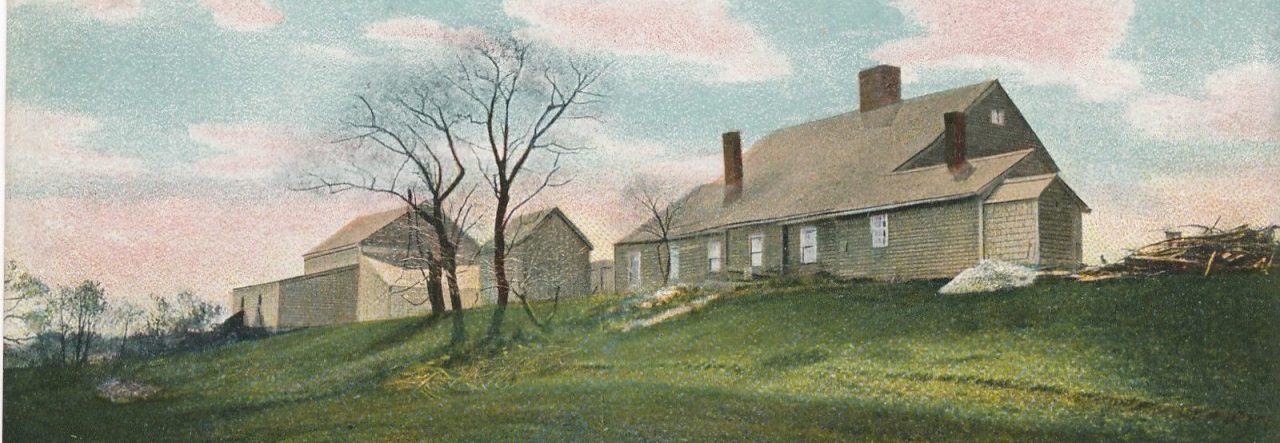(In the Danvers Herald, April 18, 2019)

(Peabody Institute Library, Danvers, 2019. Author’s photo)
Danvers’ Peabody Institute Library, one of several “Peabody Institutes” across the United States, is named for noted philanthropist and Danvers native George Peabody. He was born in 1795 in the South Parish of Danvers, which later became the Town of South Danvers and is now the City of Peabody.
(George Peabody House Museum, Peabody, Mass. Source: https://commons.wikimedia.org/wiki/File:George_Peabody_House.jpg)
George Peabody grew up poor and received little education (this was before Danvers had a public high school), so he went to work at age 12 as a clerk. He volunteered as a soldier in the War of 1812, and then returned to work in various dry-goods stores. He later impressed a wealthy merchant in New York and became his business partner.
Peabody later moved to London and established his own bank, George Peabody & Co. As a banker, he loaned money to foreign kingdoms and empires, and helped establish the credit of the US Treasury abroad. George Peabody and Co. still exists, though it was renamed a generation later to the probably more familiar “J.P. Morgan & Co.” Peabody never married or had a family, and he chose Morgan’s father as his protégé. Peabody’s bank is the predecessor to the present-day banks J.P. Morgan Chase & Co. and Morgan Stanley.
Away in London in 1852, Peabody regretted that he could not attend the celebrations of Danvers’ 100th anniversary. As an invited guest of honor, he had the privilege of giving a toast at the banquet, which followed a grand parade. Instead, Peabody sent a sealed envelope containing a toast that was dramatically read at the gala: “Education, a debt due from past to future generations.” Putting his money where his mouth was, the envelope also included an announcement that he was donating $20,000 to establish a library for Danvers.
When he finally returned home in 1856, he received a hero’s welcome. Having split only one year prior, both Danvers and South Danvers gave a joint reception for Peabody, who visited his hometown as his first stop back in the US. He arrived at the Maple St. Church in Danvers Square and was greeted by a one-hundred gun volley. From there, a parade travelled across town and through triumphal arches erected for the occasion, as people threw flowers and cannon salutes boomed.
That day he told a group of children from his former neighborhood, “(Your) early opportunities and advantages are not very much greater than were my own, and I have since achieved nothing that is impossible to the most humble boy among you.”

(Mural in the Danvers library depicting George Peabody’s return to Danvers based on drawings from the time. The mural was done by Danvers artist Richard V. Ellery as part of the Works Progress Administration’s art projects during the Great Depression. Author’s photo.)
Although stingy and thrifty in his personal life – a holdover from his impoverished childhood – he is remembered as “the father of modern philanthropy” for donating the majority of his fortune to educational institutions in America and to the Peabody Trust, which continues his mission to provide affordable housing to over 110,000 Londoners. He was admired for his charity in London, where even British nobility attended his American Independence Day party each July 4th.
In addition to the libraries of Danvers, Peabody, and Georgetown, his donations established the Peabody Academy of Sciences (now the Peabody Essex Museum) in Salem. Focused on education, Peabody donated to many universities across the United States. Harvard University, Yale University, and Phillips Academy, Andover have museums named in his honor.
Peabody made subsequent visits home with large receptions each time, and donated more than $100,000 towards the Peabody Institute, Danvers. In 1869 he returned for the dedication of the Institute, built at Peabody Park in Danvers along the banks of the Mill Pond. Guests who attended the events at the Institute that week included Senator Charles Sumner and Oliver Wendell Holmes.
The original building was a Gothic Revival structure. It caught fire in 1890, though many books and a large portrait of Peabody (that still hangs in the library today) were saved from the flames. The present structure was built in 1892 on the same spot. It featured a large auditorium and stage for events and lectures, in addition to reading rooms. The auditorium was removed in 1981 and more floors for books were built. During this renovation, space for the children’s room and Danvers Archival Center was added below ground.

(Portrait of George Peabody saved from the fire. It still hangs in the library today. Author’s photo)

(The interior of the library showing the auditorium, 1978. Photo by Ron Gagnon)

(Remnants of the auditorium stage seen in 2019. Author’s photo.)
The 1869 trip home for the dedication was Peabody’s last. A statue of him was dedicated later that year outside the Royal Exchange in London, and he died soon after. His last words were, “Danvers, Danvers! Don’t forget!,” referring to his wish to be buried in his hometown. A funeral was held for him at Westminster Abbey in the presence of Queen Victoria, who also rode in his funeral cortège. The Queen admired Peabody, and once offered him a title of nobility, which he refused as an American. Peabody was temporarily buried in the Abbey, the first American to ever be buried there.

(Dedication of Peabody statue, Royal Exchange, London. From the Illustrated London News, July 31, 1869)

(Peabody’s Funeral at Westminster Abbey. From the Illustrated London News, 1869)
But, Peabody wished to be buried in his hometown. In another first for an American, on the Queen’s orders a squadron of Royal Navy warships transported Peabody’s body across the Atlantic. After another funeral attended by the Queen’s son Prince Arthur in Peabody, Mass. (which changed its name in his honor the previous year), Peabody was buried in Harmony Grove Cemetery, Salem.
In 1995 hundreds of people gathered in Westminster Abbey to commemorate the 200th anniversary of Peabody’ birth, which shows the lasting positive effect of his philanthropy. The event included the organist playing “The Battle Hymn of the Republic” in the same church in which the British monarchs are crowned.
In March, 2018, Peabody was remembered by Google, which featured an image of him and several educational institutions that he endowed – including the Danvers library – above the search bar on Google.com.

(George Peabody and the Danvers Library on the Google homepage, March, 2018)
In the words of a London pamphlet describing Peabody soon after his death: “He acquired riches for the sake of doing good.”
——————————————————————————————————————————
Sources:
Best, Antony. On the Fringes of Diplomacy: Influences on British Foreign Policy, 1800–1945. Routledge, 2016.
Chernow, Ron. The House of Morgan: An American Banking Dynasty and the Rise of Modern Finance. New York: Atlantic Monthly Press, 1990.
Dean and Chapter of Westminster. “George Peabody, Philanthropist.” Westminster Abbey. Accessed April 1, 2019. https://www.westminster-abbey.org/abbey-commemorations/commemorations/george-peabody/.
“Funeral of George Peabody at Westminster Abbey.” New York Times, November 13, 1869. https://timesmachine.nytimes.com/timesmachine/1869/11/13/80248714.pdf.
George Peabody. Peabody Donation Presented To The Peabody Institute Danvers Massachusetts U.S. By George Peabody Of London 1862. London: J.W.L Maude, 1862. http://archive.org/details/PeabodyDonationPresentedToThePeabodyInstituteDanversMassachusettsByGeorgePeabodyOfLondon1862.
George Peabody, the Philanthropist, and Working Man’s Friend. London: W. Partridge and Co., 1870.
Glauber, Bill. “Service in London Honors Memory of George Peabody Philanthropist Spread Charitable Deeds in Great Britain, America.” The Baltimore Sun. November 17, 1995. https://www.baltimoresun.com/news/bs-xpm-1995-11-17-1995321035-story.html.
Hanaford, Phebe Ann. The Life of George Peabody: Containing a Record of Those Princely Acts of Benevolence Which Entitle Him to the Esteem and Gratitude of All Friends of Education and the Destitute, Both in America, The Land of His Birth, And in England, The Land of His Death. Boston: B.B. Russell, 1870.
“Peabody Housing Association | About Us | London.” Peabody. Accessed April 6, 2019. https://www.peabody.org.uk/about-us.
Peabody Institute, Danvers. Proceedings at the Reception and Dinner in Honor of George Peabody, Esq. of London, by the Citizens of the Old Town of Danvers, October 9, 1856. To Which Is Appended an Historical Sketch of the Peabody Institute, with the Exercises at the Laying of the Corner-Stone and at the Dedication .. Boston: H. W. Dutton & Son, 1856. http://archive.org/details/proceedingsatrec02danv.
“Peabody Institute Library of Danvers.” Massachusetts Cultural Resource Information System. Accessed April 1, 2019. http://mhc-macris.net/Details.aspx?MhcId=DAN.220.
Tapley, Harriet S. Chronicles of Danvers (Old Salem Village), Massachusetts, 1632-1923. Danvers, Mass.: The Danvers Historical Society, 1923.
Trustees of the Peabody Institute. Annual Report of the Trustees of Peabody Institute, Danvers, Mass., For the Year Ending March 1, 1898. Danvers, Mass.: Danvers Mirror Press, 1898.
Wallis, Severn Teackle. Discourse on the Life and Character of George Peabody. Peabody Institute, Baltimore, 1870.


Super story. I didn’t know all that. Did I miss why he was in London so much of his life and still loyal to Danvers and Peabody. For business purposes probably.
LikeLike
Thanks! Yep, that’s the reason why he was abroad
LikeLike
Pingback: The Endicott Estate – Specters of Salem Village